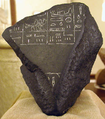Petrie Museum of Egyptian Archeology
The Petrie Museum of Egyptian Archeology is part of University College London . With around 80,000 objects, it is one of the largest collections of ancient Egyptian finds outside of Egypt .
history
The basis of the collection comes from Amelia Edwards , who donated her collection to University College in 1892 with the establishment of a chair in Egyptology . Another part of the museum is the private collection of Flinders Petrie , who sold most of the finds from his excavations to various museums around the world, but also kept some of the finds for teaching purposes. The collection has been accessible to the public since 1913.
Exhibits
The collection contains numerous finds from Petrie's excavations (e.g. Amarna , Sedment , Koptos , Lahun ), whereby the focus of the museum is not on ancient Egyptian art , but on objects from everyday life. These range from prehistoric times to modern times. Another focus of the collection are finds from Egyptian prehistory. The entire collection has been online since 2002.
The museum houses one of the largest collections of mummy portraits in the world. Two of the oldest robes from Egypt, the oldest Egyptian iron objects (pearls from Gerzeh , approx. 3300 BC), architectural fragments from Koptos and a large part of the papyri from Lahun , including the oldest gynecological and the oldest and only veterinary papyrus ( medical papyri from Lahun ).
This museum also houses the fragment of the 5th Dynasty Annal Stone , which was probably once placed in the sun shrine of King Niuserre (5th Dynasty) in Abusir . This section, referred to as P1 in professional circles , possibly belongs to one and the same important annals stone, which contains the names of the kings, like the Cairo stone (Cairo fragment No. 1) with the Cairo fragments No. 2–5 and the Palermo stone ( P ) ( Pharaohs ) from predynastic times to the 5th Dynasty (2504–2347 BC).
Web links
Individual evidence
- ↑ top part of the fragment in London
- ^ Francesco Raffaele: all fragments of the Annalenstein after Wolfgang Helck
Coordinates: 51 ° 31 '25 " N , 0 ° 7' 59" W.



